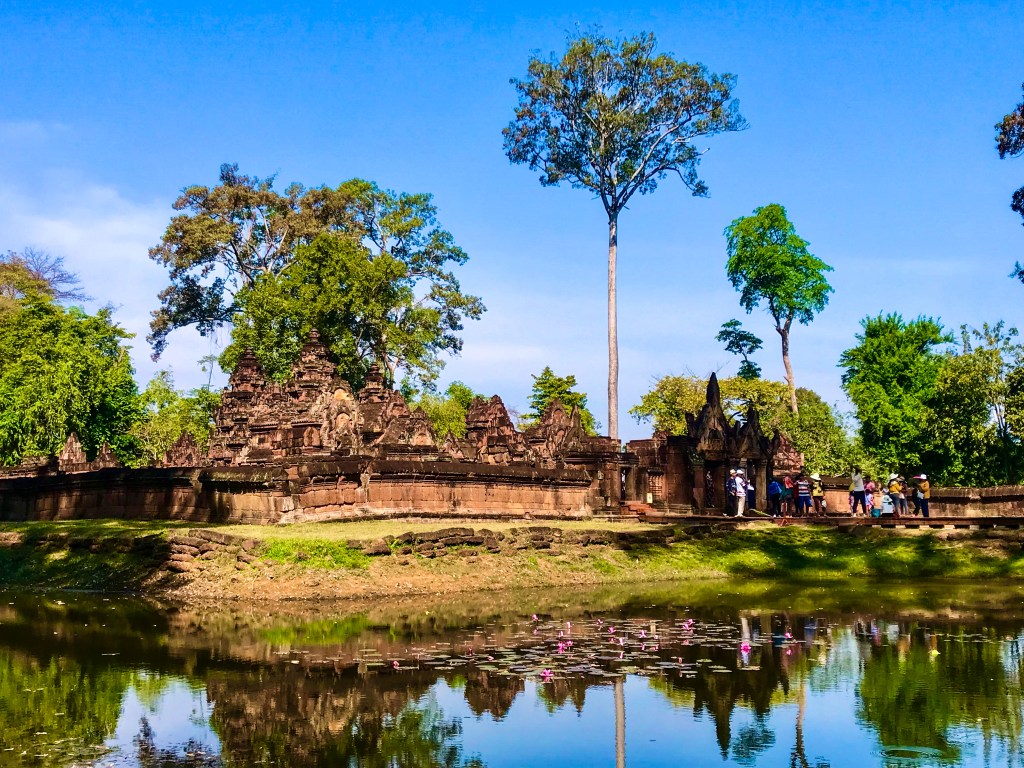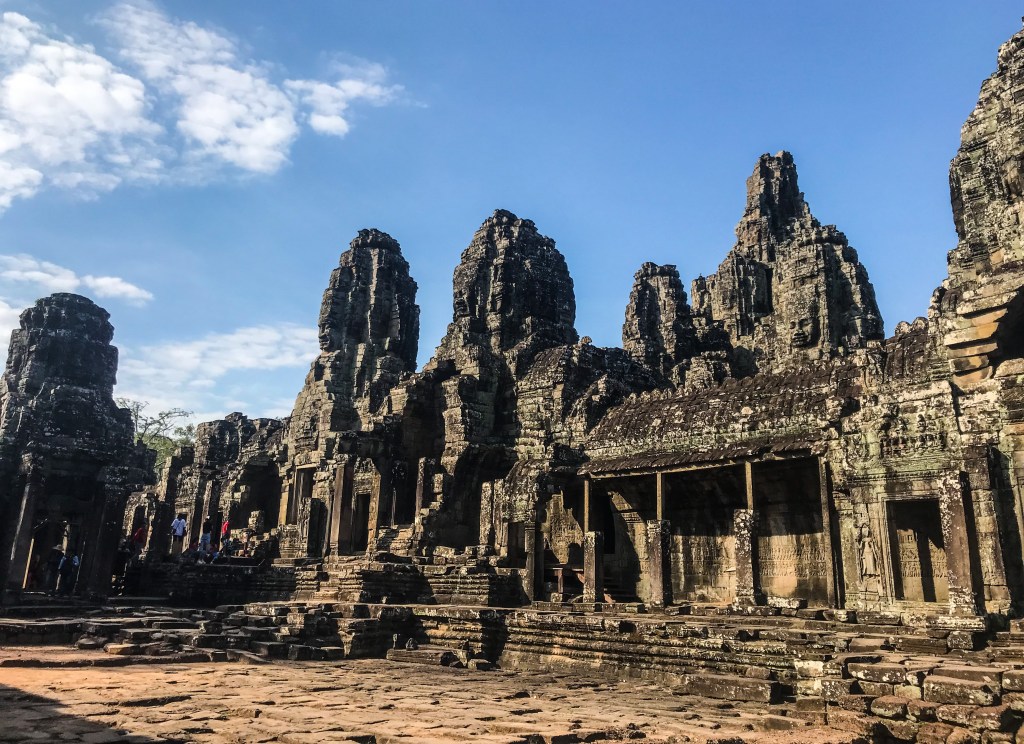Once the largest city in Southeast Asia, Angkor is now a World Heritage Site of more than 1,000 ruins, beginning with Angkor Wat, a religious structure like no other.

The towers of Angkor Wat rise from the wooded plain like colossal spearpoints, piercing the Cambodian skies as if borne by Vishnu himself. At sunrise, they appear as giant cornstalks in a field of ultimate dreams, an Oz-like Emerald City at the end of a yellow brick road.
This is one of the great marvels of the medieval world, a bucket-list destination equal in grandeur to Egypt’s pyramids and Peru’s Machu Picchu. It is, of course, a UNESCO World Heritage Site. The world’s single largest religious structure, Angkor Wat was built in the first half of the 12th century as a Hindu center and soon thereafter became a Buddhist sanctuary that welcomes worshippers respectful of both faiths.
The name Angkor Wat means, literally, “City Temple” — and it is just one building. In fact, this was once the hub of one of the largest cities in the world. More than 1,000 temples spread across 400 square miles of jungle-dominated northwestern Cambodia. Long before Indiana Jones and Lara Croft popularized archaeological adventure, the Khmer Empire battled Chams from coastal Vietnam and their traditional enemies, the Thais, to preserve and sometimes expand their territory.

It would be impossible for me to say everything I want in a single blog. Besides, I have way too many great photos for that. This column is a mere sampler of what will come in the next few weeks, as “Travels in Vietnam” focuses on neighboring Cambodia.
Angkor Wat
With a footprint of 402 acres (more than 1,000 hectares), the main attraction is worthy of adulation. Angkor — if you pronounce it correctly, it sounds more like “uncle” than “anchor” — is indeed majestic. Each early morning, hundreds of international visitors leave their hotels in the gateway city of Siem Reap and travel by tuktuk or minibus to crowd the banks of a medieval moat that surrounds the great temple. There, they stand and patiently wait for 60, 90, 120 minutes as the pre-dawn sky fades first from black to inky blue, then to a pink blush and red-orange before the golden orb of first sun peeks out from behind a temple spire.

Angkor Wat was build on a model of Mount Meru, the home of the gods in Hindu cosmology, with its primary towers symbolizing that massif’s five peaks. It was designed in such a way that viewpoints from temple terraces (the uppermost of which are not accessible to tourists) place these towers directly before the rising sun on solstices. Concentric galleries around the lower levels of the temple are carved with intricate bas-relief story boards that honor Vishnu, the “preserver” in Hinduism’s three-pronged trinity of gods, and his epic battles in shielding good from evil.
Angkor Thom and Bayon
Angkor Thom (“Great City”) succeeded Angkor Wat as the Khmer capital in the late 12th century, after a Cham invasion. Built upon the ruins of an earlier palace, the walled and moated compound embraces grounds of more than 3 square miles, and was home to nearly 1 million people. Contemporary social scientists marvel at its elaborate infrastructure.

Five causeways — one at each of the cardinal points, and an additional Victory Gate reserved for royalty — approach the city from different directions. Each is flanked by rows of 54 statues representing gods (devas) and demons (asuras), under the watchful gaze of a four-faced, 75-foot-tall bodhisattva, a Buddhist saint who has devoted his life to assisting humanity in the physical realm.
At the heart of Angkor Thom is the Bayon, a central temple whose maze of towers and pavilions surmount steep stairways and surround three levels of courtyards. Galleries of bas-relief art occupy large sections of the walls, relating stories not only of historical and mythological battles, but also of daily life for the medieval Khmer, from chess games to childbirth to raucous partying.

Ta Prohm
Local guides call this site the “Tomb Raider” temple because it was heavily featured in the 2001 Angelina Jolie film Lara Croft: Tomb Raider. There is indeed something mystical, indefinable, about Ta Prohm. Left to be overgrown by the jungle in which it nestles, absorbed Borg-like into the tendrils of fig and kapok trees, it’s not hard to imagine it as a secret land of Hobbits and Lost Boys.
Built in 1186 as a royal temple-monastery, it was also a repository of gold, diamonds, pearls and other treasures, and was home to 12,000 people — including more than 600 dancers! Many of the walls have carvings representing their fluid movements.
As for Jolie: So moved was the actress by her experience here that she adopted a Cambodian child; established a charity to support peace, health and environment; and produced a 2017 documentary, First They Killed My Father, about the horrors of the Khmer Rouge era of the 1970s.

Preah Khan
Preah Khan was built in 1184 as a center for education. Although it was modeled after Buddhist universities in India, its carvings depict many Hindu scenes, especially from the great Ramayana epic, along with homage to royal ancestors.
Surrounded, as are so many Angkor structures, by a moat, Preah Khan has three towered entrances with a broad central gateway that welcomed chariots and elephants. They are guarded by menacing images of Garuda, a mythological eagle upon which Vishnu rode, holding snakes in their claws.
The main building is a couple of city blocks from the entry. I took my time to study the fine details of Hindu legends, from the ferocity and empathy of Shiva, to the loyalty of the monkey general Hanuman, to the pleasures and travails of Rama and Krishna, both incarnations of Vishnu.

Binteay Srey
It’s a toss-up whether Ta Prohm or Binteay Srey is my favorite temple to visit. This site, about 16 miles (25 km) northeast of Angkor Wat, is well removed from the rest of the Angkor complex. Therein lies much of its charm. Built not by kings but by two wealthy and devout brothers, it is one of the earlier existing temples (completed in AD 967) and the first to be more-or-less fully restored.
Small but elegant, Binteay Srey is known as “the citadel of the women.” That name was conferred by nearby residents impressed by the voluptuous goddesses carved into the red sandstone of temple niches.
The Hindu god Shiva (“the destroyer”) is also more prominent here than at many other Angkor temples. In particular, I was enchanted by images of Shiva Nataraja, the many-armed “dancing Shiva,” and by a frieze of Kama, the god of love, raising his bow and arrow to shoot Shiva for the crime of ignoring his consort, Uma.

When you visit
Siem Reap, Cambodia’s second largest city, is the gateway to Angkor. Located just 4 miles (6.5 km) south of Angkor Wat, it is served by buses and airlines. A new international airport, now under construction, is due for completion in late 2023.
Most sites associated with the ancient city are protected within the Angkor Archaeological Park, open daily from 5 a.m. to 6 p.m. Visitors must purchase an admission pass (one day $37, three days $62) at the main entrance to the park, on the road north from Siem Reap. The ticket is checked and rechecked at many points throughout the park.
An aside: Although the official currency of Cambodia is the riel, the U.S. dollar is widely accepted and used almost interchangeably. Indeed, dollars are dispensed at ATM machines. The current exchange rate is about 4,000 riel to one dollar.
Transportation from the city is available by tuktuk (an enclosed, three-wheeled taxi) for $15, or by larger vehicles for $35 to $45. Bicycles ($3-$6) and motorbikes ($8-$12) are also available for rent. Several routes of exploration, including a “short circuit” and a “long circuit,” are well marked, and all major roads are paved.

I highly recommend hiring a private guide, at least for the first day. I was very pleased with Son Sorm, who charged $35 for a full day (5 a.m. to 2 p.m.). Son, who is 45 and speaks outstanding English, is a fount of information about Angkor and Cambodian history and spirituality. After his father and older sister were killed by the Khmer Rouge during his infancy, he spent his youth and early adulthood studying in a Buddhist monastery. He now devotes his free time and energy operating a rural school for underprivileged Khmer children, through the Cambodia Organization for Social Development.
I also suggest spending two or three hours at the Angkor National Museum in Siem Reap, perhaps after your first day’s visit. It will illuminate the historical and religious foundations of the Angkor era, from its rise in the 9th century to its decline in the 14th and 15th. In particular, the nuances of the artistic expression and architectural styles of various eras are brought to life.
As for Siem Reap: I will share much more about this charming city in a subsequent blog.



This one brings back fantastic memories. Did you try Happy House Pizza
LikeLike
Thank you, Mary! No, haven’t had pizza in ages. Is this place down near Pub Street?
LikeLike